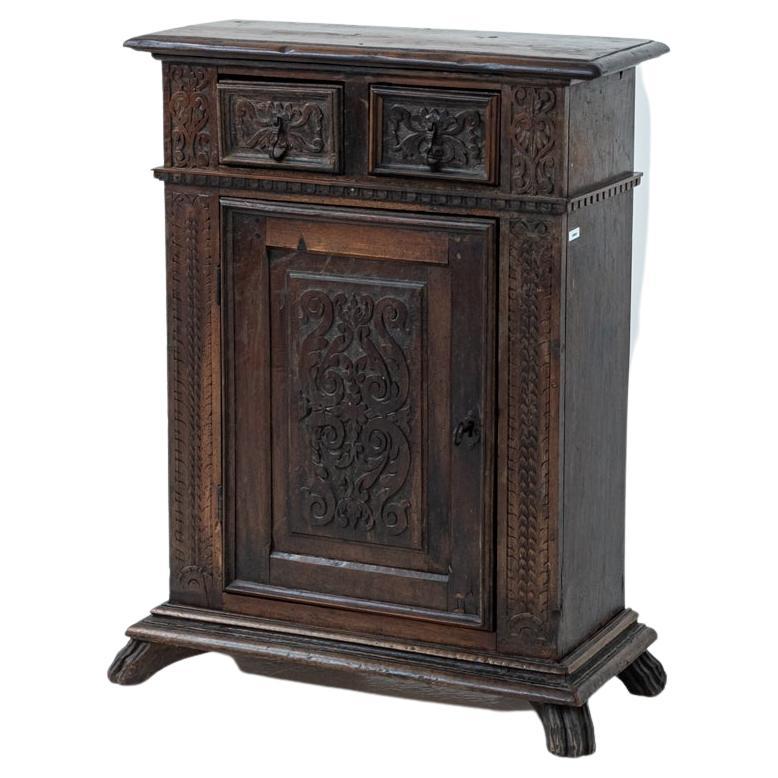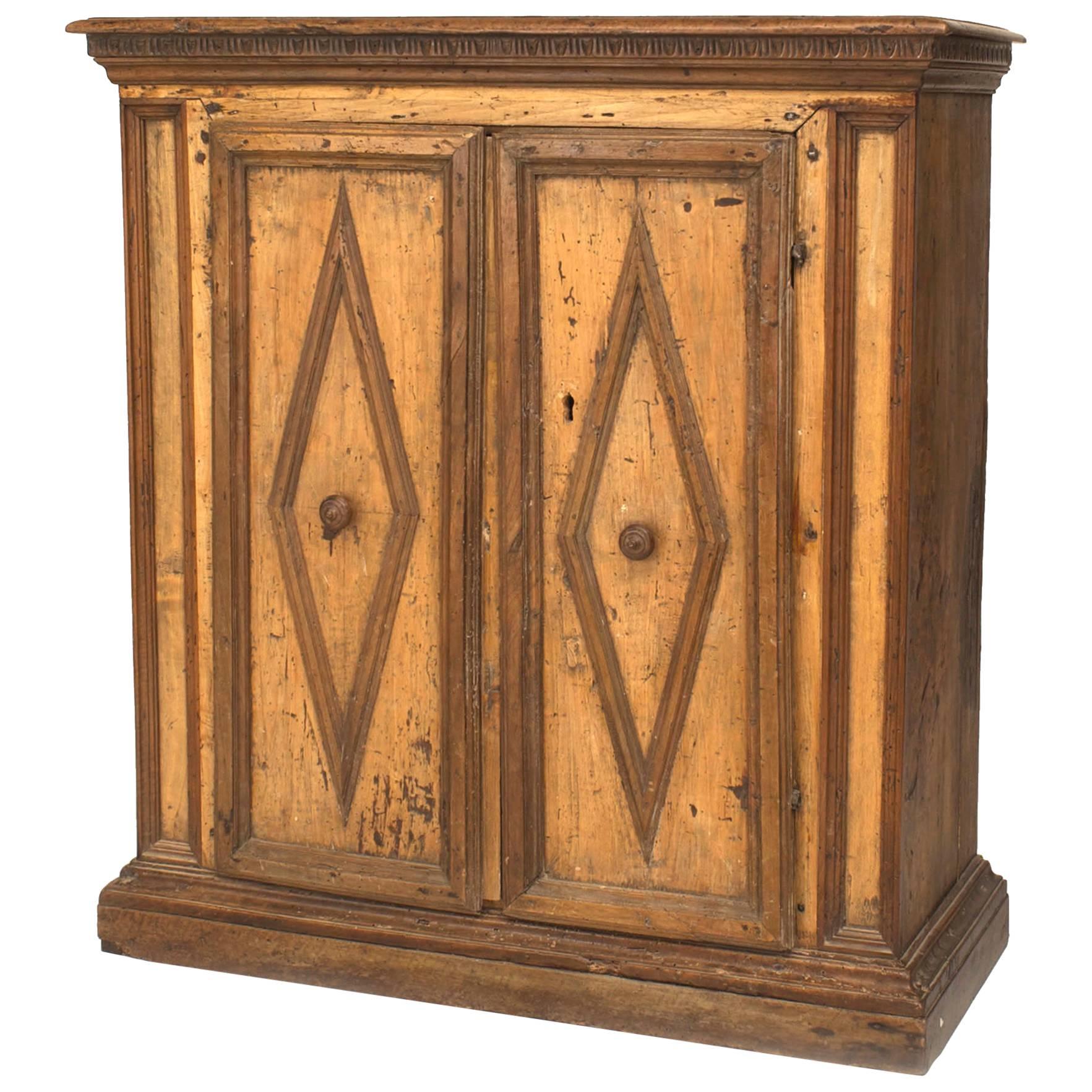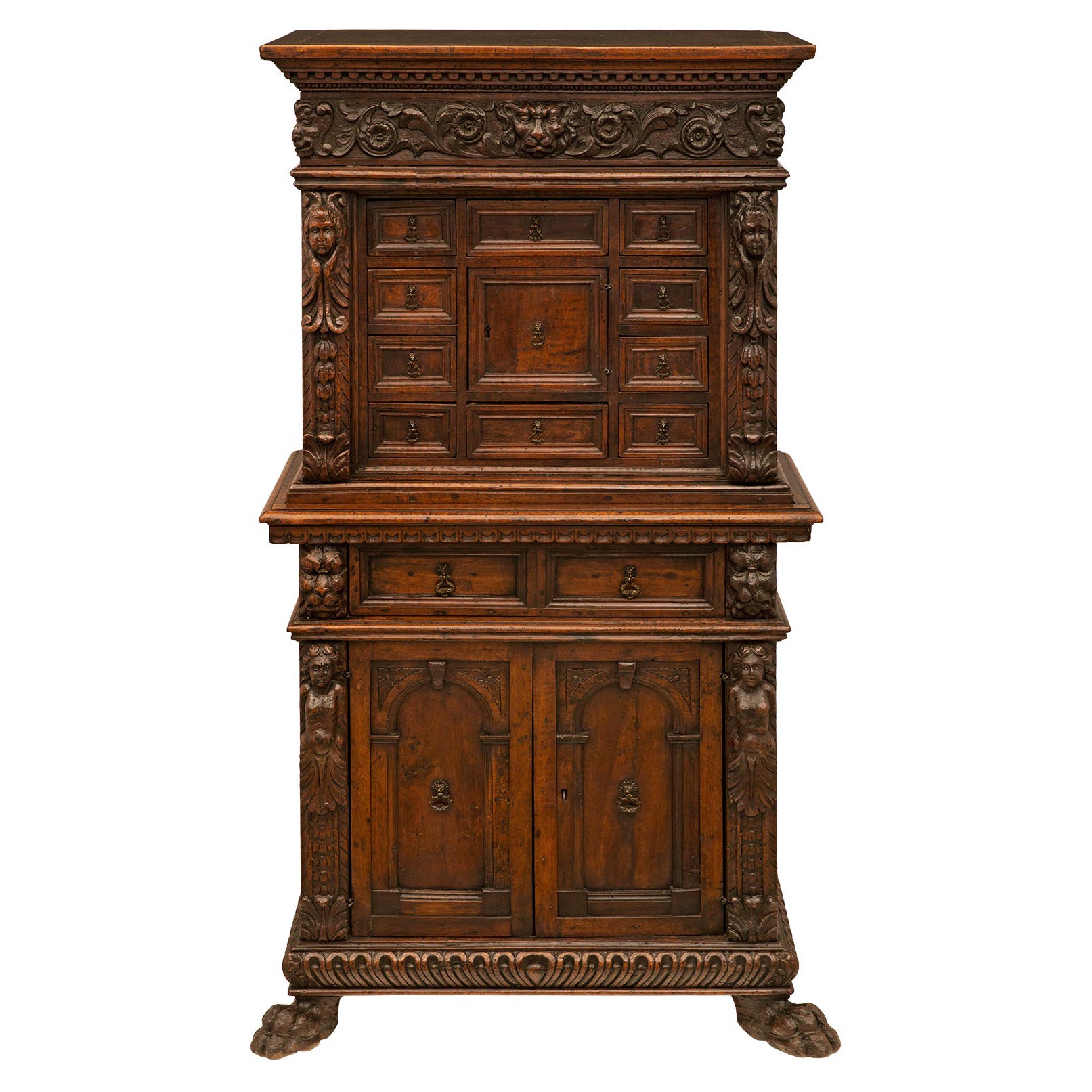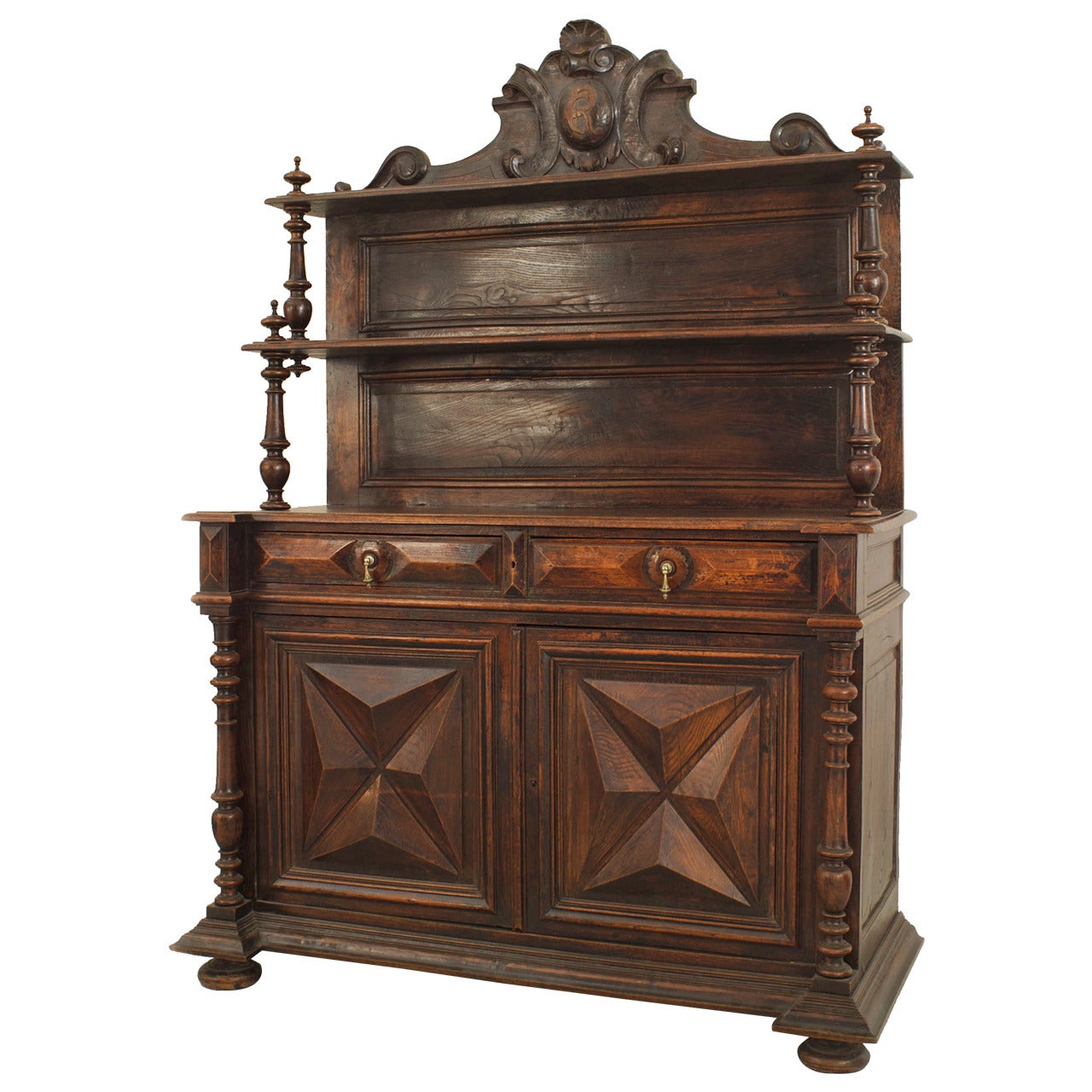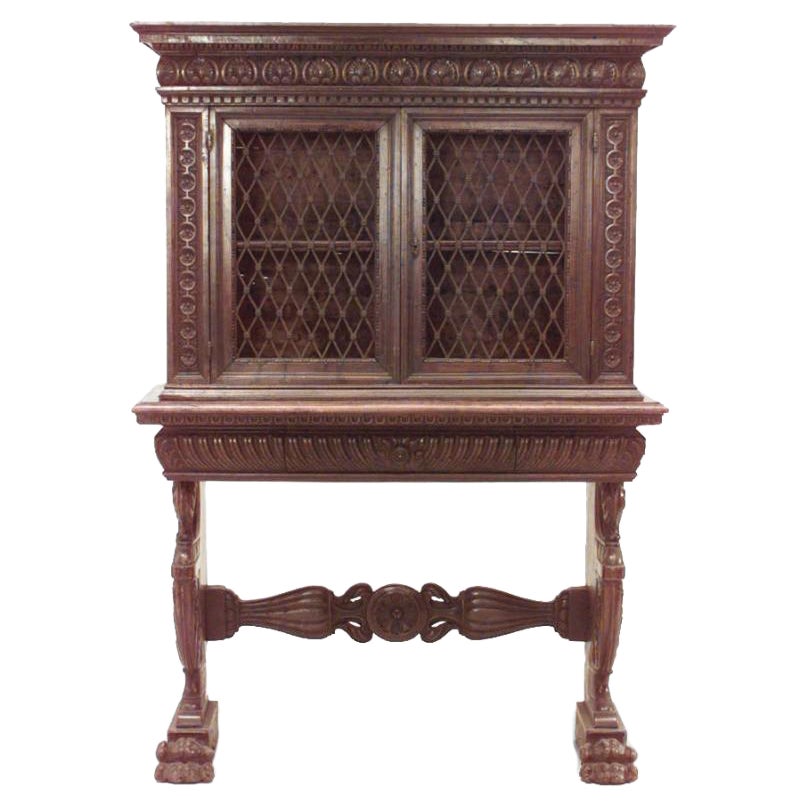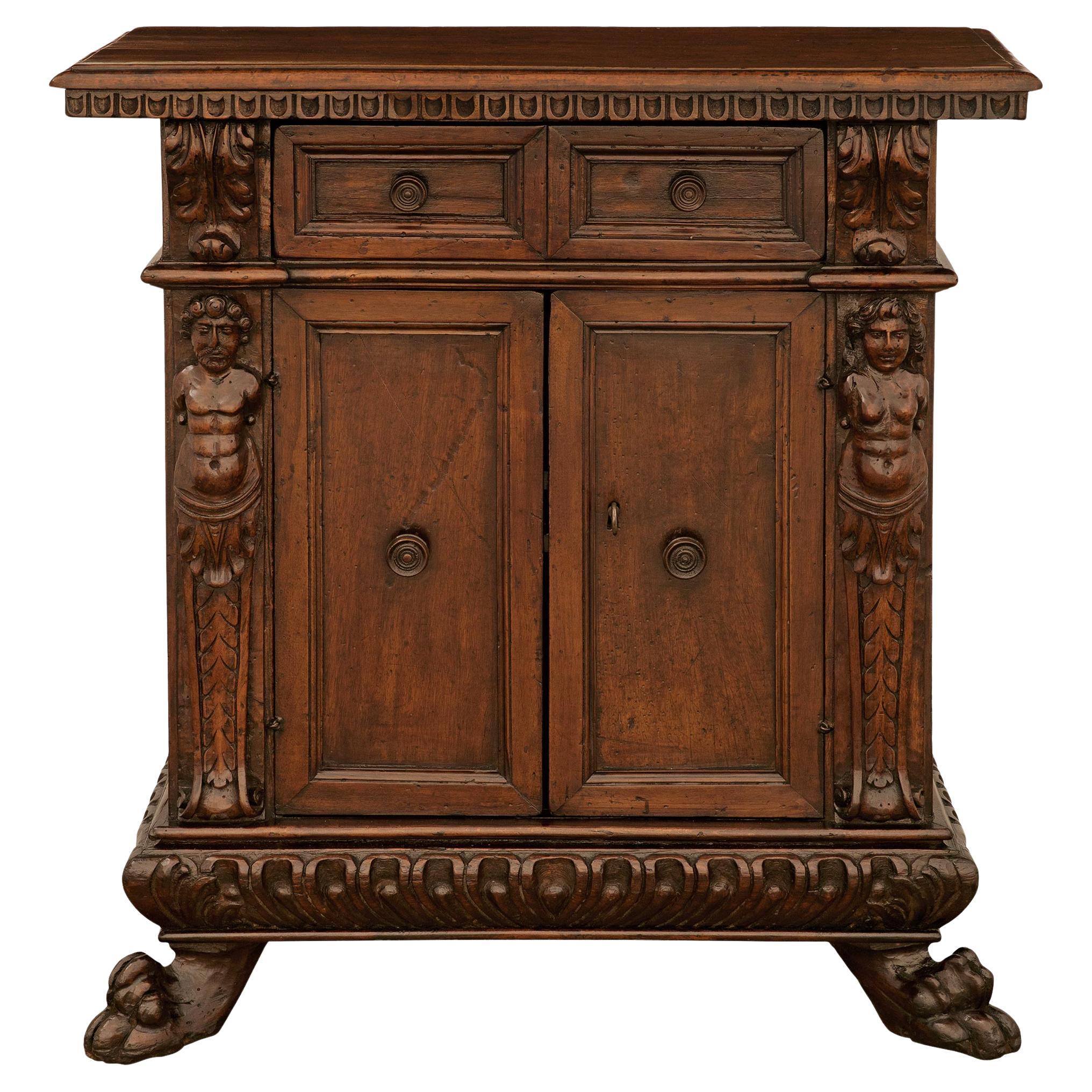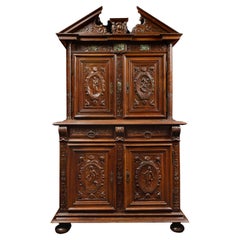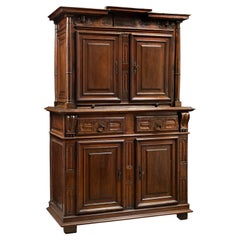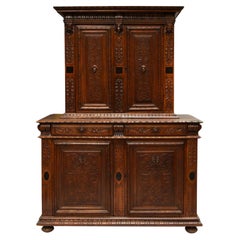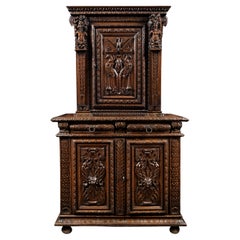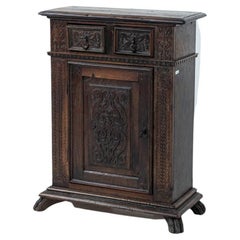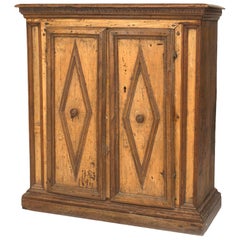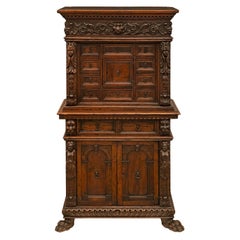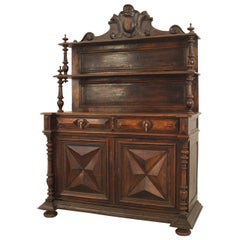Items Similar to Tuscan Renaissance Wrought Iron and Walnut Cabinet
Want more images or videos?
Request additional images or videos from the seller
1 of 9
Tuscan Renaissance Wrought Iron and Walnut Cabinet
$41,502.80
£30,854.42
€35,000
CA$57,515.41
A$64,118.62
CHF 33,440.50
MX$775,342.79
NOK 420,363.48
SEK 397,747.86
DKK 266,464.06
About the Item
The lower part
It stands on an ogee molded base and four feet with two front legs more massive and detailed than the others.
It opens with two doors and three drawers.
The vertical outer beams are enriched with feminine terms sheathed in an acanthus leaf and standing apon a veiled pedestal.
The Upper part
The upper body presents a set back and is composed of a small bottom part with two door-leaves and an original pair of wrought iron grille doors above.
The origins of the credenza and armoires date back to when its sole function related to Church ceremonies and was a humble opening in the wall of the Church which was covered by wooden panels for containing valuables such as religious artefacts positioned near the altar or in the sacristy.
Up until the 14th century, the piece was made from roughly hewn timbers with a uniform surface painted and decorated with elaborate metalwork, of which the present credenza is reminiscent. In the early 14th century, scultural decoration, was aded to the painted decoration which resulted from a more sophisticated construction of the furniture and a change in function, from being merely an opening in the wall to a decorative and moveable piece of furniture for domestic use.
The wrought iron fronted upper section would suggest that this present credenza was purposely built for a library. The wrought iron would have permitted the books to breathe in the cupboard and to show the leather spines to the viewer.
Comparative Literature
A. Pedrini, Italian Furniture and Interiors and Decorations of the 15th and 16th centuries, London, 1949, p.134, fig. 343, illustrates virtually identical beading to the panelling.
F. Schottmuller, Whohnungskulture und Mobel der Italiennischen Renaissance, Stuttgart, 1921, p.88, fig. 203, illustrates similar beading to the panelling and lion paw feet.
- Dimensions:Height: 42.13 in (107 cm)Width: 60.24 in (153 cm)Depth: 24.81 in (63 cm)
- Style:Renaissance (Of the Period)
- Materials and Techniques:
- Place of Origin:
- Period:
- Date of Manufacture:16th Century
- Condition:Repaired. Wear consistent with age and use. Minor structural damages.
- Seller Location:Saint-Ouen, FR
- Reference Number:1stDibs: LU3115327513152
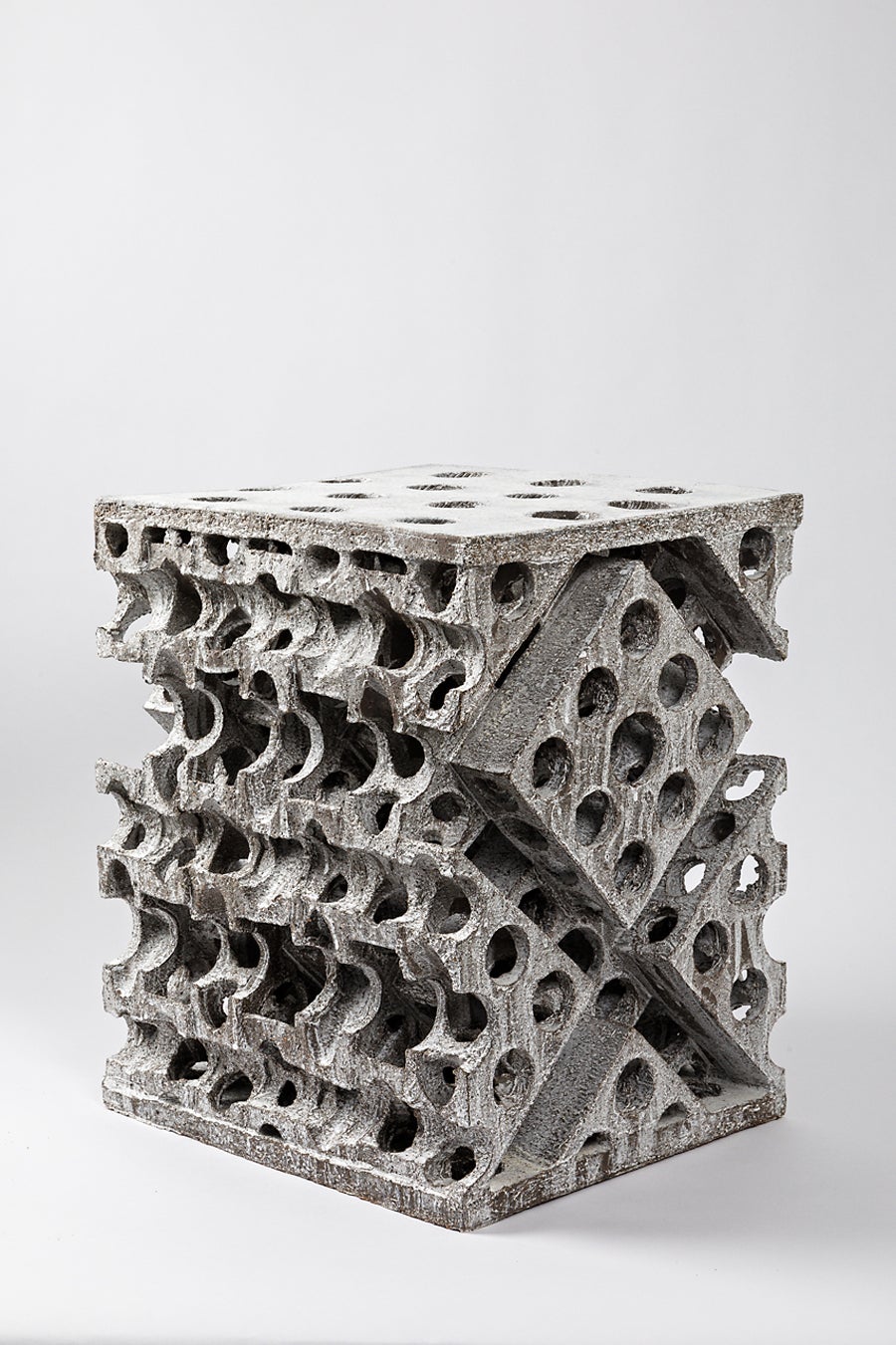
About the Seller
5.0
Vetted Professional Seller
Every seller passes strict standards for authenticity and reliability
Established in 2016
1stDibs seller since 2017
193 sales on 1stDibs
Typical response time: 1 hour
- ShippingRetrieving quote...Shipping from: Saint-Ouen, France
- Return Policy
Authenticity Guarantee
In the unlikely event there’s an issue with an item’s authenticity, contact us within 1 year for a full refund. DetailsMoney-Back Guarantee
If your item is not as described, is damaged in transit, or does not arrive, contact us within 7 days for a full refund. Details24-Hour Cancellation
You have a 24-hour grace period in which to reconsider your purchase, with no questions asked.Vetted Professional Sellers
Our world-class sellers must adhere to strict standards for service and quality, maintaining the integrity of our listings.Price-Match Guarantee
If you find that a seller listed the same item for a lower price elsewhere, we’ll match it.Trusted Global Delivery
Our best-in-class carrier network provides specialized shipping options worldwide, including custom delivery.More From This Seller
View All16th Century French Walnut Cabinet with Marble Inlays
Located in Saint-Ouen, FR
On the left post of the lower body, is written the date 1596 in a cartouche
This cabinet has two bodies. The upper part, set back, is moulded and carved. At the bottom, the cabine...
Category
Antique 16th Century French Renaissance Cabinets
Materials
Walnut
16th Century Renaissance Two-Bodied Cabinet
Located in Saint-Ouen, FR
Former collection Altounian
At the beginning of the reign of Henri II (1547-1559) the furniture’s ornamentation evolves. The few medieval motifs that were still used are eventually relinquished. Furniture becomes more sober showcasing moulded panels and perfect architecture. Cabinet-makers use ornaments such as curved fluted or plain columns, feather quills, roses or winged putti heads. High-relief carving becomes more scarce and compositions lighter. To that end cabinet-makers draw inspiration from Fontainebleau motifs filtering them and adapting them to French taste.
During this period cabinet-makers turn into a kind of architects. Indeed the architectural balance of furniture is the centre of their concerns. The study of Antic formulas is then a necessity. From this care given to proportions appear refined cabinets with pure lines.
This style is characteristic of the reign of Henri II and disappears soon after under the regency of Catherine de Medici (1560-1574) when an abundance of high and low-relief ornaments comes back on furnitures.
This two-bodies cabinet...
Category
Antique 16th Century French Renaissance Cabinets
Materials
Walnut
Renaissance Cabinet form Lyon 'France'
Located in Saint-Ouen, FR
Condition : Partly dating from the Renaissance. The backs and the drawer’s insides have been re-done.
Historical background
The 16th century is a prosperous period for Lyon...
Category
Antique 16th Century French Renaissance Cabinets
Materials
Walnut
16th Century French Carved Renaissance Cabinet
Located in Saint-Ouen, FR
Rare carved Renaissance cabinet
Period : 2nd half 16th century, ca. 1570
Origin : France, Burgundy or Languedoc
This cabinet embody the produ...
Category
Antique 16th Century French Renaissance Cabinets
Materials
Walnut
French Renaissance Cabinet with Perspectives
Located in Saint-Ouen, FR
This Renaissance Cabinet reveals the great mastery of the Lyon workshops which are at the origin of its realization. Sculptors and wood-carvers worked here in symbiosis to express an...
Category
Antique 16th Century French Renaissance Cabinets
Materials
Walnut
Renaissance Cabinet from Burgundy or Lyon Region
Located in Saint-Ouen, FR
Renaissance cabinet from Burgundy Or Lyon Region
Origin : Burgundy Or Lyon, France
Period : Second Half 16th Century, C. 1580
Height : 209cm
Length : 184cm
Depth : 71cm
Good condition
Walnut wood, original keys and keyholes
Around the middle of the 16th century the conception and ornamentation of French furniture evolves. The start of major building projects, such as the castle of Fontainebleau, gives artists a new impulse. Inventive and rich formulas are developed there, before spreading to all of Europe thanks to engravings and printed leaflets. Furthermore, Italian artists working on such construction sites bring French artists and patrons a renewed taste for the Antique.
Regarding the art of furnitures, the most complex scenes and figures are drawn from illustrated books, ornament and emblem compendiums and engraving compilations. Rather than copying those images the artisans feed their inspiration and decline the motifs in numerous variations.
The ornamental grammar marks a return to the Antique : palm leaf, acanthus, egg-and-dart, greek, scroll, fluted pilaster… It is in Primaticcio’s and Il Rosso’s stuccos made around 1540-1550 that we have to look for the origin of leather cut-outs, masks, chimaeras, harpies, sheathed figures, fruit and flower garlands that soon enrich every pieces of French furniture.
The structure of the pieces of furniture also evolve thanks to the re discovery of Antique architectures, rigorously used as a model.
This cabinet presents an imposing structure and a rich and original decor exemplifying the production of the late 16th century, infused with Italian, Antique and Fontainebleau influences.
It stands on a moulded base ornate with palm leaves. It opens with four door-leaves and two drawers in the belt. Six whimsical terms divide the facade.
The lower body is horizontally divided by three sheathed female terms. The two standing on the lateral posts are topped with fruits while the body is covered by acanthus leaves carved with precision, belted at the waist. The term standing on the central door-jamb is crowned with laurel leaves and is draped in the Antique fashion. A wincing mask hides the key hole.
The two door-leaves are centred by a beautiful mask carved in a strong relief. They wear stylised feathered headdress and are set on draperies. Straps, leather scrolls, acanthus leaves and a shell are spread around the masks. The recessed panels are secured in frames ornate with acanthus leaves.
The belt is flanked by two large mouldings enriched with variations of acanthus leaves. The drawers are carved with choux bourguignons and palm leaf motifs minutely executed. The consoles between each drawer bear tormented wincing masks, showing horns as if they were fauns or imps.
The upper body is framed by two male terms characterised by a strong and nervous musculature, their manhood hidden by drapes secured thanks to a winged lion head. The term on the left appears to be younger and is wincing while the one on the right has a beard. The central female term brings contrast with her youth and sensuality. As it is the case on the lower body, the key hole is hidden behind the mouth of a faun’s mask placed on the drapes barely covering the intimacy of the caryatid.
The panels of the upper body present an idealised architecture comprising pilasters and sinuous broken pediments. The pilasters are flanked by two satyrs with goat legs. In the centre appears an important lion mask.
The terms of the upper body support the cornice. The entablature carries palm leaves and roses alternating as well as an egg-and-dart frieze. The cornice is adorned with acanthus motifs.
On the sides, the carving is executed flat. A central rose is surrounded by scrolls, flowers and choux bourguignons.
We can admire the variety of the elements employed. The artist vary with great genius many different ornamental motifs : palm leaf, egg-and-dart, laurel leaf, roses, scrolls … But the artist went even further as each profile and each face is individualised and presents different features. You can take a look at the faces of the satyrs flanking the upper body’s panels. The talent of the artist is undeniable.
It makes no doubt the patron who commissioned this cabinet was an aesthete looking for the greatest quality.
The artist who authored this cabinet had a great mastery of composition both in the general design and in the individual panels. They probably drew inspiration from engravings and drawings made especially for the making of this piece of furniture or not. They seem to be familiar with the style of Jacques Androuet du Cerceau. Indeed, we can find in Du Cerceau’s engravings the same juxtapositions of leather cut-outs, masks and fruits. The terms and caryatids used on the facade could very well be inspired by his work as well. The cabinet-maker was also undoubtedly observant of Hugues Sambin, the most famous cabinet-maker and sculptor in the Burgundy of the time. Like Du Cerceau, Sambin left an important ensemble of models particularly useful for the design of cabinets. His publication De l’Oeuvre de la diversité des termes dont on use en architecture (1572) was an essential book for every artisan.
All the motifs testify of the artisan’s high knowledge of forms as well as the precision of their tools : super imposition of ornamental elements, foliages, architectural cut-outs, flat and high reliefs alternating, palm leaves inscribed in circular spaces, wincing faces. It is also a testimony of the artisan’s familiarity with Italian and Fontainebleau productions.
Because of the proficiency of the cabinet-maker in so many different models, this cabinet truly is a master-piece authored by the hand of an authentic master.
The generous carvings executed with great rigour and virtuosity evoke an origin close to Burgundy and Lyon workshops. This cabinet was made by a master of the region during the Second French Renaissance.
Literature
BOCCADOR Jacqueline, Le mobilier français du Moyen-Âge à la Renaissance, Édition d’art Morelle Mayot, 1996
BOS Agnès (dir.), Mobilier du Moyen âge et de la Renaissance, La collection du musée du Louvre, Louvre éditions...
Category
Antique 16th Century Renaissance Cabinets
Materials
Walnut
You May Also Like
Antique Tuscan Walnut Cabinet with Inlays
Located in Milano, IT
Antique Tuscan furniture from the late 16th, early 17th century of fine Italian manufacture, with splendid mastery of woodwork.
The cabinet is...
Category
Antique Early 1800s Italian Rococo Revival Cabinets
Materials
Wood
$3,320 Sale Price / item
20% Off
Italian Renaissance Tuscan Walnut Cabinet
Located in Queens, NY
Italian Renaissance Tuscan (late 17th Century) walnut cabinet having 2 doors with a diamond design.
Category
Antique Late 17th Century Italian Renaissance Cabinets
Materials
Walnut
Italian 17th Century Baroque Period Walnut and Iron Specimen Cabinet
Located in West Palm Beach, FL
A handsome Italian 17th century Baroque period Walnut and iron specimen cabinet. The three door eleven drawer cabinet is raised by impressive paw feet below a mottled border with a striking reeded gadroon like design. At the center are two doors decorated with arch shaped recessed panels with fine foliate carvings and iron lion head pulls flanked by remarkable columns with large acanthus leaves and richly carved personages. The two drawers also display handsome lion head iron...
Category
Antique 17th Century Italian Baroque Cabinets
Materials
Iron
English Renaissance Walnut Hutch Cabinet
Located in Queens, NY
English Renaissance-style (18/19th Century) walnut hutch cabinet with 2 shelves under a carved pediment top with 2 drawers over 2 diamond carved doors on ...
Category
Antique Late 18th Century British Renaissance Cabinets
Materials
Walnut
Italian Renaissance Style Walnut Cabinet
Located in Queens, NY
Italian Renaissance style (17th Century and Later) walnut cabinet on stand with 2 grill doors above a frieze drawer & trestle supports.
Category
Antique 17th Century Italian Renaissance Cabinets
Materials
Bronze
An Italian 17th century Baroque Period Walnut and Iron cabinet
Located in West Palm Beach, FL
A handsome and most decorative Italian 17th century Baroque Period Walnut and Iron cabinet. This wonderful two door, two drawer cabinet is raised on impressive paw feet below a mottl...
Category
Antique 17th Century Cabinets
Materials
Iron
More Ways To Browse
Tuscan Furniture
Wrought Iron Legs
Antique Renaissance Cabinets
Lion Cabinet
Italian Walnut Two Door Cabinet
Antique Tuscan Furniture
Wrought Iron Panel
Italian Renaissance Cabinet
Renaissance Cabinet Italy
Standing Painted Cabinet
Antique Wrought Iron Panel
Used Kitchen Cabinets London
Italian Renaissance Doors
Italian Renaissance 15th Century
Lion Paw Cabinet
Tuscan Renaissance
Cabinet With Lion Paw Feet
Cabinet With Wrought Iron Doors
